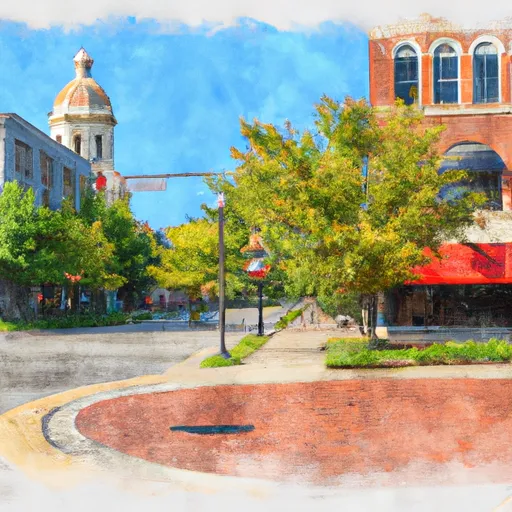-
 Snoflo Premium
Snoflo Premium
Get unlimited access to all our content
With no Ad interruptions! - Start Your Free Trial Login with existing account
Columbus
Eden Index
Climate
8.3
•
Recreation
5.4
•
Community
3.1
•
Safeguard
5.9/10

Located in southern Indiana, Columbus experiences a humid continental climate with hot summers and cold winters. The city sits on the Flatrock River, which is part of the White River watershed. The river provides opportunities for fishing, kayaking, and canoeing. Other outdoor recreational opportunities in Columbus include hiking and biking along the People Trail, exploring the city's numerous parks and green spaces, and visiting the nearby Brown County State Park for camping, horseback riding, and scenic drives. The hydrology constituents in Columbus are carefully monitored by the city's water utility department to ensure safe and clean drinking water for residents.
What is the Eden Index?
The Snoflo Eden Index serves as a comprehensive rating system for regions, evaluating their desirability through a holistic assessment of climate health, outdoor recreation opportunities, and natural disaster risk, acknowledging the profound impact of these factors on livability and well-being.
Climate Health Indicator (CHI): 8.3
Columbus receives approximately
1112mm of rain per year,
with humidity levels near 81%
and air temperatures averaging around
12°C.
Columbus has a plant hardyness factor of
6, meaning
plants and agriculture in this region thrive during a short period during spring and early summer. Most
plants will die off during the colder winter months.
By considering the ideal temperature range, reliable water supplies, clean air, and stable seasonal rain or snowpacks, the Climate Health Indicator (CHI) underscores the significance of a healthy climate as the foundation for quality living.
A healthy climate is paramount for ensuring a high quality of life and livability in a region, fostering both physical well-being and environmental harmony. This can be characterized by ideal temperatures, reliable access to water supplies, clean air, and consistent seasonal rain or snowpacks.
Weather Forecast
Streamflow Conditions
Patoka-White
Area Rivers
Patoka-White
Snowpack Depths
Patoka-White
Reservoir Storage Capacity
Patoka-White
Groundwater Levels
Recreational Opportunity Index (ROI): 5.4
The Recreational Opportunity Index (ROI) recognizes the value of outdoor recreational options, such as parks, hiking trails, camping sites, and fishing spots, while acknowledging that climate plays a pivotal role in ensuring the comfort and consistency of these experiences.
Access to outdoor recreational opportunities, encompassing activities such as parks, hiking, camping, and fishing, is crucial for overall well-being, and the climate plays a pivotal role in enabling and enhancing these experiences, ensuring that individuals can engage in nature-based activities comfortably and consistently.
Camping Areas
| Campground | Campsites | Reservations | Toilets | Showers | Elevation |
|---|---|---|---|---|---|
| Salt River Rec Area | None | 428 ft | |||
| Clark State Forest | 45 | 851 ft | |||
| Delaney Creek Park | None | 584 ft | |||
| South Harrison Co Park | None | 754 ft | |||
| Starve Hollow State Rec Area | 200 | 552 ft | |||
| Buffalo Trace Co Park | 64 | 803 ft | |||
| Salt Lick Creek - Cordell Hull Lake | 145 | 574 ft | |||
| Jackson - Washington State Forest | None | 672 ft | |||
| Defeated Creek - Cordell Hull Lake | 155 | 527 ft | |||
| Deam Lake State Rec Area | 185 | 533 ft |
Nearby Fishing
Nearby Ski Areas
Catastrophe Safeguard Index (CSI):
The Catastrophe Safeguard Index (CSI) recognizes that natural disaster risk, encompassing floods, fires, hurricanes, and tornadoes, can drastically affect safety and the overall appeal of an area.
The level of natural disaster risk in a region significantly affects safety and the overall livability, with climate change amplifying these risks by potentially increasing the frequency and intensity of events like floods, fires, hurricanes, and tornadoes, thereby posing substantial challenges to community resilience and well-being.
Community Resilience Indicator (CRI): 3.1
The Community Resilience Indicator (CRI) recognizes that education, healthcare, and socioeconomics are crucial to the well-being of a region. The CRI acknowledges the profound impact of these elements on residents' overall quality of life. By evaluating educational resources, healthcare accessibility, and economic inclusivity, the index captures the essential aspects that contribute to a thriving community, fostering resident satisfaction, equity, and social cohesion.

